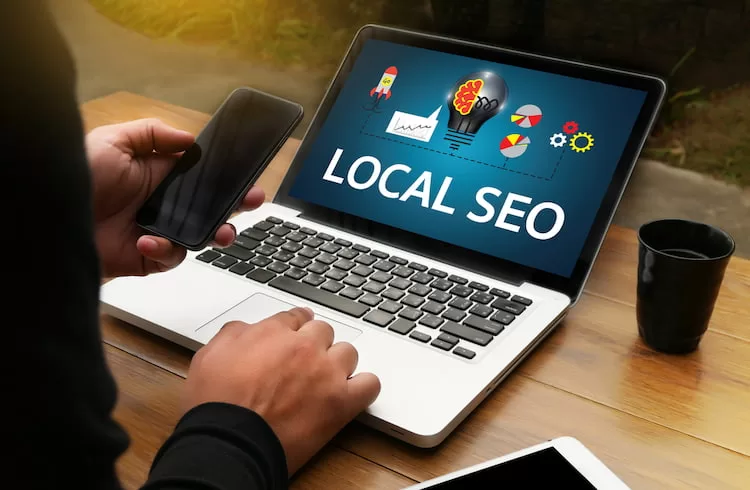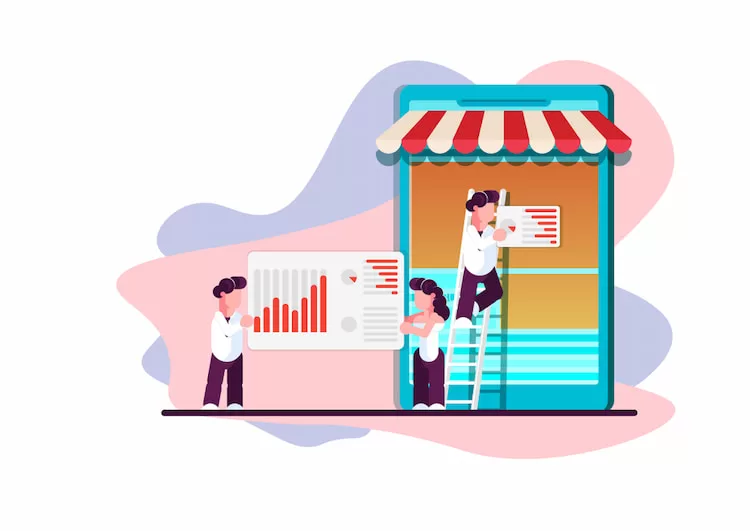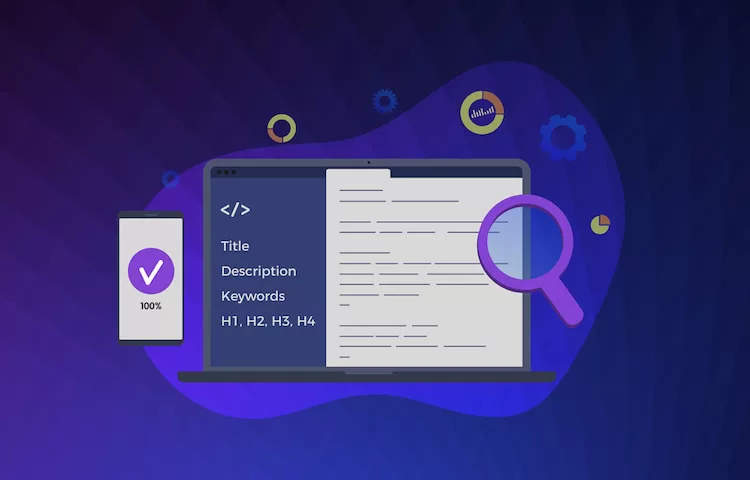Insights
Local SEO Checklist: The Essential Guide For Your Local Business
06/03/2023
43
Local SEO: The Overview
Before getting into the details, let’s first go over some basic concepts to make sure we are all on the same page.
What is a local search?
A local search is a search performed by a user to get information related to a certain location. This is an integral part of local SEO and has been going through some changes recently.
What is local SEO?
Local SEO is the process of optimizing your website to rank at the top of search results pages, especially when users search for keywords related to a certain location.
Often, users will use the formula “product/service + at/in + geographical area” to look for information, so these are the keywords you want to rank for. For example, “digital marketing services in Ho Chi Minh City” or “delicious restaurants in Paris”, etc.
When there is a query about something in a certain area, Google will leverage the Google Maps tool to provide users with the most relevant results, such as the names of businesses that provide those services or products locally.
At the same time, Google also prioritizes businesses with positive reviews to improve the search experience.

Local SEO supports searches for local information
Why is local SEO important to businesses?
According to the statistics, it reveals up to 46% of queries on Google include local intent. Moreover, local SEO makes it easier for users to find your website on search engines. This is also a tool for businesses to reach their target customers.
Of course those without a local SEO strategy can still build relationships with online users, but there is a much lower chance that they are potential customers. In other words, you lose your footing when the starting pistol fires.
In short, local SEO helps companies reach and attract customers in the location where they are doing business. The results are especially rewarding for high locality businesses such as tourism, restaurants, and hotels.
How does local SEO work?
The mechanism of local SEO is similar to a normal search on Google. When a user inputs a query, Googlebot will scan the Google Index to provide the best results for the user.

The mechanism of local SEO is similar to a Google search
However, local SEO uses a different set of ranking factors, including:
- The location the user searched for
- NAP citations (mentions of critical business information business i.e. name, address and phone number)
- List of keywords and information used in Google My Business
- Online reviews
- Keywords in online reviews
- Number of “Check-ins” at that location
- Number of shares to social networks
- Number of stars rated on Google Maps for business
What is Google Snack Pack?
Google Snack Pack refers to the first 3 local businesses displayed by Google when users search for keywords related to a specific area. Some statistics show that more than 30% of users click on the Snack Pack results.
For example, when you input a query “parks in ho chi minh city”, Google will return the following results:

An example of Google Snack Pack with the query “parks in ho chi minh city”
Optimize your website for Google Snack Pack and you will enjoy an upsurge in site traffic, as now your site is displayed on the top of search results pages.
What is keyword spamming?
Keyword spamming or stuffing refers to the practice of repeating keywords and content with no added value, which causes annoyance to readers and risks being penalized by Google.
Consequently, websites that stuff keywords in their content will be “shunned” by both users and search engines, and are unable to climb to the top of SERPs.
Local SEO: The Benefits for Your Business
When done right, local SEO provides 5 following key benefits.
Increase website ranking
Local SEO helps increase your site rankings on both Google Search and Google Maps. As a result, the site will reach more users hence more conversion.
Boost conversion rate
If you want more leads, it’s better to target a specific locality (a city) than a bigger area (a country). With local SEO, you can reach the right target audience with a smaller cost while enjoying a higher conversion rate.
Enhance brand awareness
Effective local SEO helps your website rank top on both regular and local search results. When your site exposure increases, brand awareness will follow.

Local SEO helps improving brand awareness
Improve ROI
With local SEO, you can target a smaller group in a specific location with much lower cost. Also, research has shown that when performing local searches, users are more likely to make a purchase. Therefore as long as your targeting is on, your return on investment can’t be off.
Contribute to the success of the overall SEO strategy
The practice of local SEO will let Google know about the presence of your business on the map by providing the following information:
- Images and products of the business
- Frequency of online activities of the business
- Customer reviews
- Frequency of information update from the business to customers
- Other factors to help assess whether the business is really operating at the displayed position

Local SEO is an integral part of the overall SEO strategy
In summary, through the assessment of the above factors and others, Google will decide the final ranking of the website.
Local SEO: Is It Just Another Name of SEO?
In essence, local SEO consists of all the tasks of SEO but targets a specific geographical area, while SEO has larger or general targeting, such as across the country or globally.
In other words, local SEO is a part of the following SEO activities:
- Technical SEO: Optimize technical elements on the site
- On page SEO: Optimize “internal” elements i.e. elements on the site
- Off page SEO: Optimize external elements that can affect the site
What Are Local Citations?
Local citations refer to the online information of the business such as name, address, phone number, etc. When building a local citation, make sure:
- The citations are accurate and consistent; and
- There are multiple related citations.
How to Choose The Right Keywords for Local SEO?
Find keywords with the formula “Service in Locations”
Most businesses today are assigned with specific keywords. Just follow the formula “Service in Locations” and you will get a good list of keywords.
Read more: Looking into the search intent of your users will help you choose appropriate keywords.

Identify keywords with the formula “Service in Locations”
Get more keywords with Google Autocomplete
After getting the first list of keywords, use Google Autocomplete to collect more keyword suggestions. How to do it? Just input one keyword into Google (don’t enter!) and write down relevant queries that Google suggests. Do this to every keyword on your list to expand it.
Learn the keywords of your competitors
Google is known for being “trendy” because they are very good at listening to the needs and experience of users. If your competitor is ranked first on Google SERPs, there is a high likelihood that their keywords are in the top 10. Therefore, use the right SEO tools to analyze their keywords for better ideas that you can use for your site.
Local SEO Checklist: The Step By Step Process
Complete the following checklist to make sure local SEO is your powerful ally.
Optimize brand identity
Logo is one of the first factors that search engines “meet” when crawling a website, so make sure every element of your brand identity is optimized for local SEO effectiveness. When optimize your logo, make sure:
- The image file name should contain the main keyword besides the brand name and the name of the product/service.
- The logo should have the right alt tag.
Insert keywords in the title, description and URL tags
To ensure your local SEO effort pays off, remember to insert keywords in important tags such as the title tag and website description.

Optimize on page elements for the best local SEO results
Even the URL should contain keywords to help Google and users understand where your business is and what it provides.
Update the contact information on your site
Next, update your business’s contact information on the website including the address, company name, phone number, fax number, etc. This helps Google and users understand clearly about the company, making your local SEO more effective.
Note: The calling code should be made clear and accurate to your business location. Because if Google recognizes where your business is, your site can rank higher in the search results.
In addition, putting contact information in the subpages also helps with local SEO.
Set up Google Maps for your business location
If you want users and later customers to be able to get to the exact location of your business, install the Google Maps.

Use Google Maps to pinpoint your business’ location
Also, set up more directions to guide the user to the exact location of your business. This will greatly increase the local SEO value of the site.
Install Google My Business for your site
This is an indispensable step when doing local SEO. Google My Business helps Google verify business information on websites. So to leverage Google My Business, pay attention to these factors:
- Business information should be provided in the most complete and accurate way on Google My Business.
- The opening and closing hours of the business should reflect reality.
- Customer reviews on Google about your business should be responded to, despite the nature of the review.
- Company or product images should be added to Google My Business to increase brand awareness.
Use schema to declare business information to Google
Structured data markup aka schema is one of the most effective ways to boost local SEO effectiveness.

Leverage schema to declare business information to Google
If your forte is programming, take some time to look deep into schema because it is used to present business information in the simplest form to Google.
Register your business information on other search engines
Although Google tops the list of search engines today, it’s wise not to neglect other runner-ups such as Bing, Yahoo, Baidu, etc. Just follow the same steps above to register your business information on these tools to expand your reach and potentially increase customer databases.
Build official social accounts for your business
Businesses staying active on social platforms such as Facebook, LinkedIn, Youtube and the like also contribute to the results of local SEO in particular and overall SEO in general. Schedule some time to invest on your official social pages and create online communities to support local SEO plans.
Respond to customer reviews on Google
The key is to respond to any review you receive without filtering, no matter how many stars they give.

Take good care of reviews on Google to enhance local SEO results
This is an opportunity for you to exhibit professionalism and willingness to improve the quality of your products and services to better serve your customers. Moreover, search engines will also appreciate businesses that are actively trying to satisfy the needs of their users.
Build links to local websites for quality backlinks
Similar to SEO, the more often your brand name appears on local websites which are relevant to your services and products the better, because this is a factor for Google to put your site in a better light.
These quality backlinks are votes of confidence to elevate your site to the top when users search for local products or services.
Design an all-device-friendly website
Online searches can take place on multiple devices. Therefore make sure your website is compatible with every device so that users don’t bounce once they click.
This principle is not only applicable for local SEO but also for overall SEO, because a mobile-friendly website is a prerequisite to the competition for attraction, retention and conversion of online users.
Invest in blog content
After you have completed all the above steps, it’s time to build an effective blog for your business. To promote local SEO impact, focus on getting more locally relevant keywords, then update the latest content to your Google My Business to present it to users when they find you on Google.

Invest in blog content for enhanced local SEO
Local SEO: Important Notes
To implement a successful local SEO plan, there are 7 important notes to keep in mind.
Localize your language and keywords
When you focus on building a website for a certain region or country, it’s best to use the language of the local people. The same applies for keywords. If you want to reach and attract certain local groups, use keywords that they input in search engines.
Declare your business sector
Make sure search engines like Google know which business sector your website belongs to, otherwise your path to potential customers are unnecessarily lengthened.
Keep business information consistent across channels
Once you have decided on the scope of your business activities, make sure all information about your business is consistent across every channel, including your official websites, social pages and so on.

Keep the information on your site and other official channels consistent
Focus on user satisfaction
On Google, users can rate a business on a scale from 1 to 5 stars to express their (dis)satisfaction. Of course, just like hotels, the higher the better, and the more likely to be ranked top by Google.
But it’s always easier said than done, because getting consistently good reviews from users remains a challenge for all businesses, especially the newcomers.
Therefore, alongside improving the quality of your services and products, pay serious mind to “complaints” i.e. negative reviews to uproot the problem, make sure it never happens again and re-earn the trust of your customers.
Combine with on page SEO
Combining local SEO with Onpage SEO is more than necessary because, to appeal to local users, you need to tweak your site’s look and feel, the keywords, images, titles, and all.
On the other hand, other business information including the hotline number, online maps, etc. should also be added in the introduction to improve the effectiveness of local SEO.
Check backlink quality
Inbound links or backlinks are evaluated by Google to rank websites. The better quality the backlinks are, the higher the ranking score and website authority.
So don’t neglect the task of checking inbound link quality and building links only to those reputable websites in relevant sectors.

Backlinks play an important role in local SEO
Outsource local SEO activities for the best results
Outsourcing local SEO is a common choice for many businesses, especially those who want to expand to a new area. Also, because it takes time to see tangible SEO results, businesses often turn to professional service providers for all-in-one solutions or partial support.
Final Thoughts
We hope the local SEO checklist clears away any doubt you have about implementing an effective local optimization plan for better Google SERP results. A part of the overall SEO strategy, local SEO is critical in helping your business reach the right target audience in a certain geographical location with a minimal investment of time, money and effort.
To update the latest trends and important information about SEO in general, visit On Digitals today. Or if you have a more specific need about a marketing solution, contact us today for tailored services.
NEWEST POSTS
- Consumer Confidence Index Vietnam: A Boost in The Thriving Market
- A Closer Look at Vietnam’s Primary Payment Methods
- The Top B2C Digital Marketing Trends in Vietnam to Help You Achieve Your Goals
- SEO company Vietnam: How to elevate your digital marketing efforts
- What are the advantages of doing business in Vietnam?
Read more

